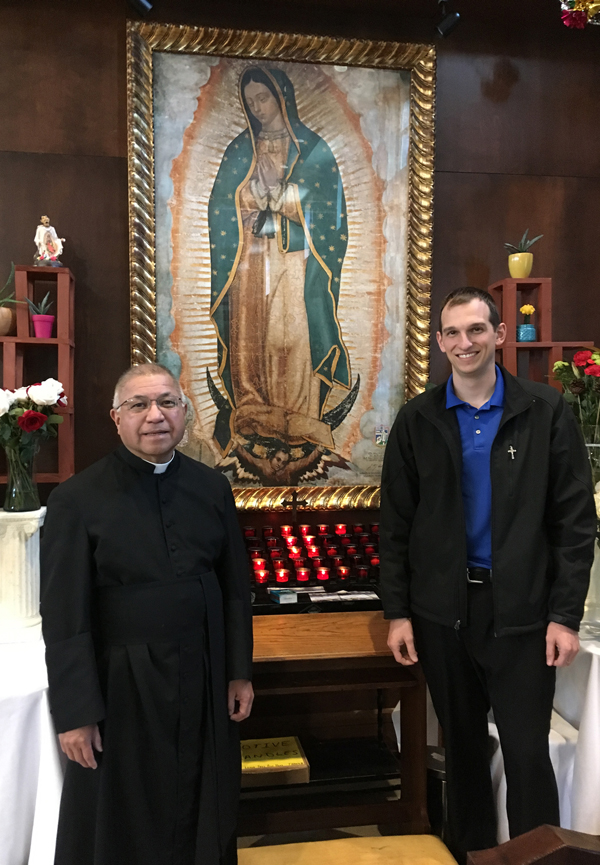By Lindsay Steele
The Catholic Messenger
IOWA CITY — Our Lady of Guadalupe carries special significance for Catholics of Mexican heritage, but her impact extends far beyond that, said Scott Foley, a seminarian who is serving his pastoral year at St. Patrick Parish. “One thing that is often overlooked is that Our Lady of Guadalupe is Empress of the Americans – not just Mexico, but also the United States and all of North and South America.”

Father Rudolph Juarez and seminarian Scott Foley stand next to a replica of the image of Our Lady of Guadalupe at St. Patrick-Iowa City.
On Dec. 3, Foley taught parishioners about the symbols associated with the “miraculous” image of Our Lady of Guadalupe found in the tilma (wrap) of St. Juan Diego. Later in the day, Father Rudolph Juarez offered a similar presentation in Spanish. The presentations were part of the parish’s Our Lady of Guadalupe celebrations; her feast day was Dec. 12.
The apparitions of Mary to Juan Diego in Mexico in 1531 came about 10 years after the Spanish invasion of the Yucatan Peninsula, Foley explained. The Catholic faith of the invaders made it a “tough sell” for the natives, who primarily engaged in pagan practices. It was at this time that Mary began to appear to Juan Diego, an Aztec and a Catholic convert.
According to official Catholic accounts, the first apparition occurred on the morning of Dec. 9 at a place called the Hill of Tepeyac, near modern-day Mexico City. Speaking to Juan Diego in his native tongue, Mary identified herself as “mother of the very true deity” and asked for a church to be built at that site in her honor.
Juan Diego brought this message to the bishop, who was initially resistant. However, “Our Lady gave multiple miracles to prove the truth of her words through him,” Foley said. On Dec. 12, she filled Juan Diego’s tilma with Castilian roses, which did not exist in Mexico. Roses would not have been able to grow in that region in December due to cold temperatures. “This was miraculous in itself.”
When Juan Diego released his tilma to present roses to the bishop, the image of Our Lady of Guadalupe was revealed for all to see. The bishop then believed the message and worked to fulfill Our Lady’s requests, Foley said. This had a huge impact on the church in Mexico. “Not only the Spanish took notice of the image of Our Lady of Guadalupe, so did the natives. Around 9 million natives converted to Catholicism in the first seven years after the apparitions to St. Juan Diego.” Taking into account the population of Mexico at the time, Foley said this would be like 250 million Americans deciding to become Catholic in the next seven years.
He noted that the symbols in the tilma contained both Aztec and Christian symbols. Some of the most significant Aztec images? Her loose hair signifies that she is a virgin. The blue mantle symbolizes heaven, abode of the supreme gods. The arrangement of the stars on Mary’s mantle, clear to the Aztec priests, corresponds with their location on Dec. 12, 1531. The pink tunic, the color of the rising sun, is a sign of the renewal of life. The moon, the footstool for Mary, signifies the dethronement of moon gods. The hands folded in prayer honor someone more powerful than oneself. The angel holding her clothing signifies Mary’s humanity. The bow around Mary’s waist would have been worn as a sign of pregnancy by Aztec women.
Christian images include the blue color of the mantle as a sign of immortality and eternal happiness with God in heaven. The sash is a symbol of virginity, purity and devotion to God. A cloud surrounding Mary signifies an invisible and inexpressible God. The leaves on the tunic are a symbol of paradise. The ermine lining of Mary’s tunic signifies her royalty and purity, and the stars on her mantle indicate her title of the Queen of Heaven. Her inwardly turned eyes symbolize contemplation and spiritual union with God, while her smile expresses joy in being in the presence of the Creator, Foley explained.
The durability of the original image is baffling, Foley noted. The image is not painted, nor can modern science explain how the design was created. He said that copies of the tilma would disintegrate in 10 years or less. At one point, nitric acid was accidentally spilled on the tilma in a botched cleaning attempt of the frame, yet the tilma was not destroyed. “There is only a mark on the upper right hand side.”
While the image of Our Lady is “miraculous and still baffles modern science in multiple ways,” Foley told The Catholic Messenger that what may be more intriguing is its enduring impact. “The Image of Our Lady of Guadalupe personally opens the hearts of regular people to Jesus, be it in the 1530s, or today. There is something about the tenderness of a mother, our mother Mary, that can surprise us, that can open us to God’s love.”
Parishioner Cynthia Gillham attended the presentation knowing little about the image which is so revered, especially by the Hispanics at St. Pat’s. “It has a whole new meaning for me, having observed that presentation! I was captivated by all of it. …Our faith is so blessed to have this image to call ours.”










